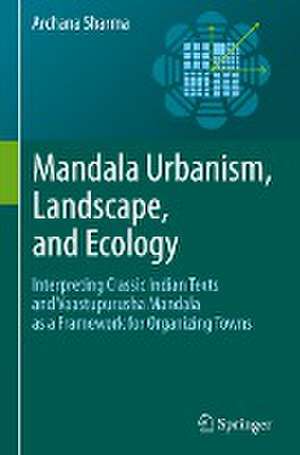Mandala Urbanism, Landscape, and Ecology: Interpreting classic Indian texts and Vaastupurusha mandala as a framework for organizing towns
Autor Archana Sharmaen Limba Engleză Hardback – 12 apr 2022
| Toate formatele și edițiile | Preț | Express |
|---|---|---|
| Paperback (1) | 519.32 lei 6-8 săpt. | |
| Springer International Publishing – 13 apr 2023 | 519.32 lei 6-8 săpt. | |
| Hardback (1) | 525.35 lei 6-8 săpt. | |
| Springer International Publishing – 12 apr 2022 | 525.35 lei 6-8 săpt. |
Preț: 525.35 lei
Preț vechi: 618.05 lei
-15% Nou
Puncte Express: 788
Preț estimativ în valută:
100.53€ • 109.54$ • 84.71£
100.53€ • 109.54$ • 84.71£
Carte tipărită la comandă
Livrare economică 24 aprilie-08 mai
Preluare comenzi: 021 569.72.76
Specificații
ISBN-13: 9783030872847
ISBN-10: 303087284X
Pagini: 112
Ilustrații: XIII, 112 p. 106 illus., 55 illus. in color.
Dimensiuni: 155 x 235 mm
Greutate: 0.36 kg
Ediția:1st ed. 2022
Editura: Springer International Publishing
Colecția Springer
Locul publicării:Cham, Switzerland
ISBN-10: 303087284X
Pagini: 112
Ilustrații: XIII, 112 p. 106 illus., 55 illus. in color.
Dimensiuni: 155 x 235 mm
Greutate: 0.36 kg
Ediția:1st ed. 2022
Editura: Springer International Publishing
Colecția Springer
Locul publicării:Cham, Switzerland
Cuprins
Chapter1. Introduction and Methodology.- Chapter2. Ancient Indian Design and Town Planning Principles as a Frame for Case Studies.- Chapter3. Other Interpretive Frameworks.- Chapter4. Shiva Temples.- Chapter5. Deliberations.
Notă biografică
Archana Sharma seeks ways for cities to coexist in mutualistic symbiosis with nature from the intersectional vortices of design, planning, science, and policy. Dr. Sharma is an Associate Professor at Morgan State University. Past affiliations with the University of Tennessee, Knoxville, Maharaja Sayajirao University, National University of Singapore, RMIT University in Australia, and Harvard Kennedy School of Government continue to shape her ongoing transdisciplinary works. She has offered advisory services to local and international stakeholders ranging from the City of Baltimore to the United Nations, underscored by the ethos of an equitable and just environment for all. This is the second book on design thinking for Dr. Sharma.
Textul de pe ultima copertă
Classic Indian texts and Vaastupurusha Mandala are not often discussed in the western discourse on urbanism, even while much of these predate the commonly taught European writings. This book sheds light on some of those forgotten concepts, thus making the lesser discussed classic Indian town organization ideas accessible to architecture, landscape, and urban planning students worldwide. The resonance of these concepts in present times are reviewed through case studies of select Hindu temple towns in India. Furthermore, the author underscores the formal abstraction of the classic Indian Mandala and transplants the discourse from sociology to socio-ecologically adept trans-disciplinary design thinking. The creative interpretations offer a premise to start revising classic models for current practice to influence the urbanism and ecology of a place in accordance with the changing climate.
Reviews
“India has a strongly developeddesign, planning language and principles or sutras as shared through ancient Indian texts approximately developed through 5000-550 BCE such as, Kamikagama and Suprabhedgama, Matsyapurana, Bhavishyapurana, and Manasara. Kautilyashastra from around 5th BCE builds additional layers of complexity to the discourse. Sharma’s book orients the students to some of these classic ancient principles while taking them on an investigative journey of applicability of these at temple precinct and town level.”
- Pankaj Jain. Professor and Head of the Department of Humanities and Languages, FLAME University, Pune, India
“Our changing climate is forcing the rapid evolution of the pressing issues concerning urbanism. Sharma’s book draws upon traditional Indian frameworks to be embedded in design methods, to creatively mitigate the current problems to be addressed in urbanism.”
-Tom Verebes. Professor of Architecture, New York Institute of Technology
"Dr. Sharma presents an enlightening and groundbreaking perspective on the Hindu Temple landscape, placing it in the nexus of urbanism and ecology."
- Diane Jones Allen, Professor of Landscape Architecture, University of Texas at Arlington
Reviews
“India has a strongly developeddesign, planning language and principles or sutras as shared through ancient Indian texts approximately developed through 5000-550 BCE such as, Kamikagama and Suprabhedgama, Matsyapurana, Bhavishyapurana, and Manasara. Kautilyashastra from around 5th BCE builds additional layers of complexity to the discourse. Sharma’s book orients the students to some of these classic ancient principles while taking them on an investigative journey of applicability of these at temple precinct and town level.”
- Pankaj Jain. Professor and Head of the Department of Humanities and Languages, FLAME University, Pune, India
“Our changing climate is forcing the rapid evolution of the pressing issues concerning urbanism. Sharma’s book draws upon traditional Indian frameworks to be embedded in design methods, to creatively mitigate the current problems to be addressed in urbanism.”
-Tom Verebes. Professor of Architecture, New York Institute of Technology
"Dr. Sharma presents an enlightening and groundbreaking perspective on the Hindu Temple landscape, placing it in the nexus of urbanism and ecology."
- Diane Jones Allen, Professor of Landscape Architecture, University of Texas at Arlington
Caracteristici
Investigates the applicability and revision of ancient planning frameworks Introduces ancient Indian design and planning principles and grid templates Explains landscape, urbanism, and ecology centered around Hindu temples
